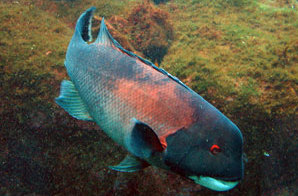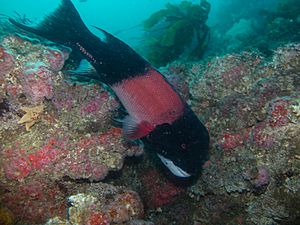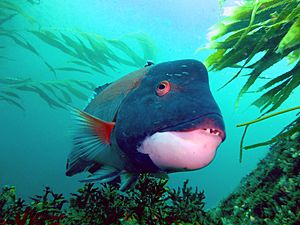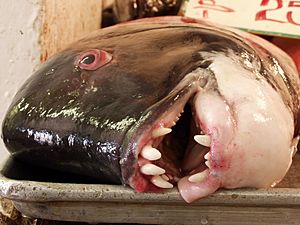California sheephead facts for kids
Quick facts for kids California sheephead |
|
|---|---|
 |
|
| Conservation status | |
| Scientific classification | |
| Synonyms | |
|
The California sheephead (Semicossyphus pulcher) is a cool fish that lives in the eastern Pacific Ocean. You can find it from Monterey Bay, California, all the way down to the Gulf of California, Mexico. This fish can live for up to 20 years! It can grow to be about 3 feet (91 cm) long and weigh up to 35 pounds (16 kg).
California sheephead are carnivores, meaning they eat other animals. They love to live in rocky reefs and kelp forests. Their favorite foods are sea urchins, molluscs (like snails and clams), and crustaceans (like crabs and lobsters).
One super interesting thing about California sheephead is that they are all born female! As they get older, some of them change into males. This change depends on things like how much food is available. Because of this, they are called protogynous hermaphrodites. They are active during the day, looking for food. At night, they find safe places to hide from predators.
Sadly, the California sheephead is considered a vulnerable species. This is because too many are being caught by fishing boats, especially off the coast of Southern California. When big fish are caught, it often means the males are removed. This can mess up the balance of males and females, which makes it harder for them to have babies and keep their populations strong.
Contents
Description

Male and female California sheephead look quite different! Males are usually bigger. They have black heads and tails, with a wide, reddish-orange middle section. They also have red eyes and a bumpy forehead. Female sheephead are a dull pink color with white bellies.
Both male and female sheephead have white chins. They also have large, strong teeth that stick out. These teeth are perfect for pulling hard-shelled animals off rocks. They can also give a painful bite if you're not careful! After they grab their prey, they use strong bones in their throat to crush the shells into tiny pieces.
California sheephead can grow to be about 3 feet (91 cm) long and weigh around 35 pounds (16 kg). All sheephead are born female. They usually change into males when they are about 1.5 feet (45 cm) long. How old they are when they change depends on their environment, like how much food they can find. If there's lots of food, they can live up to 21 years. If food is hard to find, they might only live for 9 years.
Etymology
The scientific name for the California sheephead is Semicossyphus pulcher.
- Semicossyphus comes from Greek words. Semi means "half," and kossyphos means "a kind of fish."
- Pulcher is a Latin word that means "beautiful."
In French, this fish is called the labre Californien. In Spanish, it's known as the vieja de California.
Life and Habits
The California sheephead lives in kelp forests and rocky reefs. Here, it finds plenty of food like sea urchins, molluscs, lobsters, and crabs. When they reproduce, the eggs are released into the water. These eggs hatch into tiny larvae that float around as plankton.
Like many fish in the wrasse family, sheephead are protogynous. This means they are all born female. The biggest females in a group will eventually change into males. This happens because of changes in their hormones, often triggered by social signals. The male and female fish look so different that this change is one of the most dramatic among wrasses!
Because only the largest fish become males, fishing rules that set a minimum size for catches can cause problems. If only big fish are caught, it means more males are removed. This can lead to fewer males in the population, which then affects how many babies can be born.
Where They Live
California sheephead live in different areas depending on the shape of the coastline. They prefer rocky-reef areas, especially those with lots of hiding spots. They spend most of their daytime in these complex areas.
These fish tend to stay in a relatively small area. They don't move around much. They likely choose rocky areas with kelp because these places offer more food and better places to hide from predators. While they mostly stick to rocky reefs and kelp beds, they sometimes swim into sandy areas to look for food.
Ecology
The California sheephead is a very important fish in the rocky reefs and kelp beds of Southern California. It's a protogynous hermaphrodite, meaning it changes sex. This fish is also valuable for both commercial and recreational fishing. How they live and grow can change depending on the local environment.
Feeding
The California sheephead is a carnivore that eats animals living on the seafloor. It mostly hunts during the day in rocky and sandy reef areas. They have good hunting grounds that let them stay in small, permanent areas.
As a large wrasse, it eats sea urchins and other small animals without backbones. This makes them very important for keeping kelp forests healthy. By eating lots of urchins, they help control the urchin population. This stops the urchins from eating too much kelp, which helps the kelp forests grow and supports many other fish species.
However, sheephead can change what they eat if their main food isn't available. Fish that eat a lot of crabs and sea urchins tend to grow bigger and change sex at a larger size. Fish that eat more clams, barnacles, and bryozoans might not grow as large. Since they hunt during the day, they have special body features that help them find food in open areas, even when their prey tries to defend itself. They can hunt alone or in groups. Larger fish often go after prey with tougher shells.
Predation
When a California sheephead is in danger, it can release special chemicals from its skin if it gets hurt. These chemicals tell other fish that a predator is nearby. This helps other sheephead and even different kinds of fish know to be careful. These warning signals are only released when the skin is broken, so they are a good sign of danger.
Movement and Territory
The daily life of a California sheephead is shaped by the sun. Like many fish active during the day, they travel between their safe hiding spots and their feeding areas twice a day. They might also make extra trips to places where they lay eggs. These movements help them find food or a mate while staying safe from predators.
How much they move depends on their sex and size. Large males tend to stay in the same spot more than females. However, males also cover a wider area, and this changes with the seasons. During the time they lay eggs, males travel further each day. They also make daily trips into deeper water. Females, who might move more between male territories, don't expand their areas as much during this time. After these offshore trips, males return to shallower water before nightfall, suggesting they have a special area for laying eggs. As evening comes, about 10 to 15 minutes after sunset, the fish become less active and find shelter for the night. This "quiet" time is when larger reef predators are most active.
Male and female California sheephead often have overlapping home ranges. Even though they are not usually considered territorial, males can act territorial, especially during the egg-laying season. This territorial behavior usually happens around sunset.
Reproduction and Life Cycle
California sheephead populations can have different numbers of babies. This often depends on the water temperature. Fish in cooler waters might use less energy to grow, leaving more energy for reproduction. The number of fish and the ratio of males to females in these sex-changing fish are also linked to their environment and human activities. Fishing pressure and environmental changes can affect how many babies each population of California sheephead can produce.
Different groups of California sheephead have different sex ratios (how many females compared to males). They also change sex at different sizes. Sheephead are also "harem spawners." This means each male protects a group of females that he mates with.
Sex Change
California sheephead can change from being a female that can have babies to a male that can have babies during their lifetime. This happens because of social reasons. Usually, a female changes sex when it would be better for her to be a male to have more babies.
This change takes between two weeks and several months. Hormones are thought to be involved in this process. During the change, the female parts disappear, and male parts appear. The exact timing of this change is stopped by aggressive actions from dominant males. But if the main male is removed, it can trigger the change. There's a time when the fish can't reproduce while its body is changing. Once the change starts, it only goes one way – a male cannot change back to a female. In the later stages of the change, fish might act like males but still have some female parts.
Human Interaction
People have been fishing for California sheephead since at least the late 1800s. Fishing for them became very popular in 1928. This was probably because they were easy to find close to ports. From the 1940s to the 1980s, people weren't very interested in them, and fewer were caught.
However, in the late 1980s, commercial fishing started supplying live fish to Asian markets and restaurants. This caused fishing for sheephead to grow quickly. Restaurants often want smaller, younger sheephead for their aquariums, which are usually females before they have had a chance to reproduce.
People also fish for California sheephead for food, using fishing rods or spears. Some are caught alive for aquariums. In 1999, it was estimated that over 132,000 sheephead were caught by recreational and commercial fishers. Younger fish are often caught in commercial traps, while smaller adults are caught by recreational fishers. In 2009, fishing boats made over $333,000 from sheephead, mostly from selling live fish.
California sheephead are also important because they eat purple sea urchins and red sea urchins. By eating these urchins, they stop them from eating too much kelp. This helps kelp forests grow and stay healthy. More kelp means more homes for other valuable fish like kelp bass and white seabass.
Conservation Status
The California sheephead is considered a vulnerable species. This is because too many are being caught by fishing boats, especially off the coast of Southern California. When the largest fish are caught, it often means the males are removed from the population. This causes the biggest females to change into males. This can lead to fewer eggs being produced, which weakens the population in that area.
Since males are often targeted by spearfishers, there might not be enough males, which can reduce how many babies are born. Fishing pressure has increased, and catches have gone down over the last ten years. To help control how many sheephead are caught and prevent overfishing, the California Department of Fish and Wildlife made rules in 2001. These rules limit the size of sheephead that can be caught and where they can be caught.
Before 1999, there were very few size limits for catching sheephead. But in 1999, the California Department of Fish and Game set a minimum catch size of 12 inches (30 cm) for commercial fishing. They added the same rule for recreational fishing in 2001. To further reduce commercial catches, the minimum size was increased to 13 inches in 2001. Also, the recreational limit of 10 fish per person was reduced to five.
See also
 In Spanish: Vieja de California para niños
In Spanish: Vieja de California para niños




